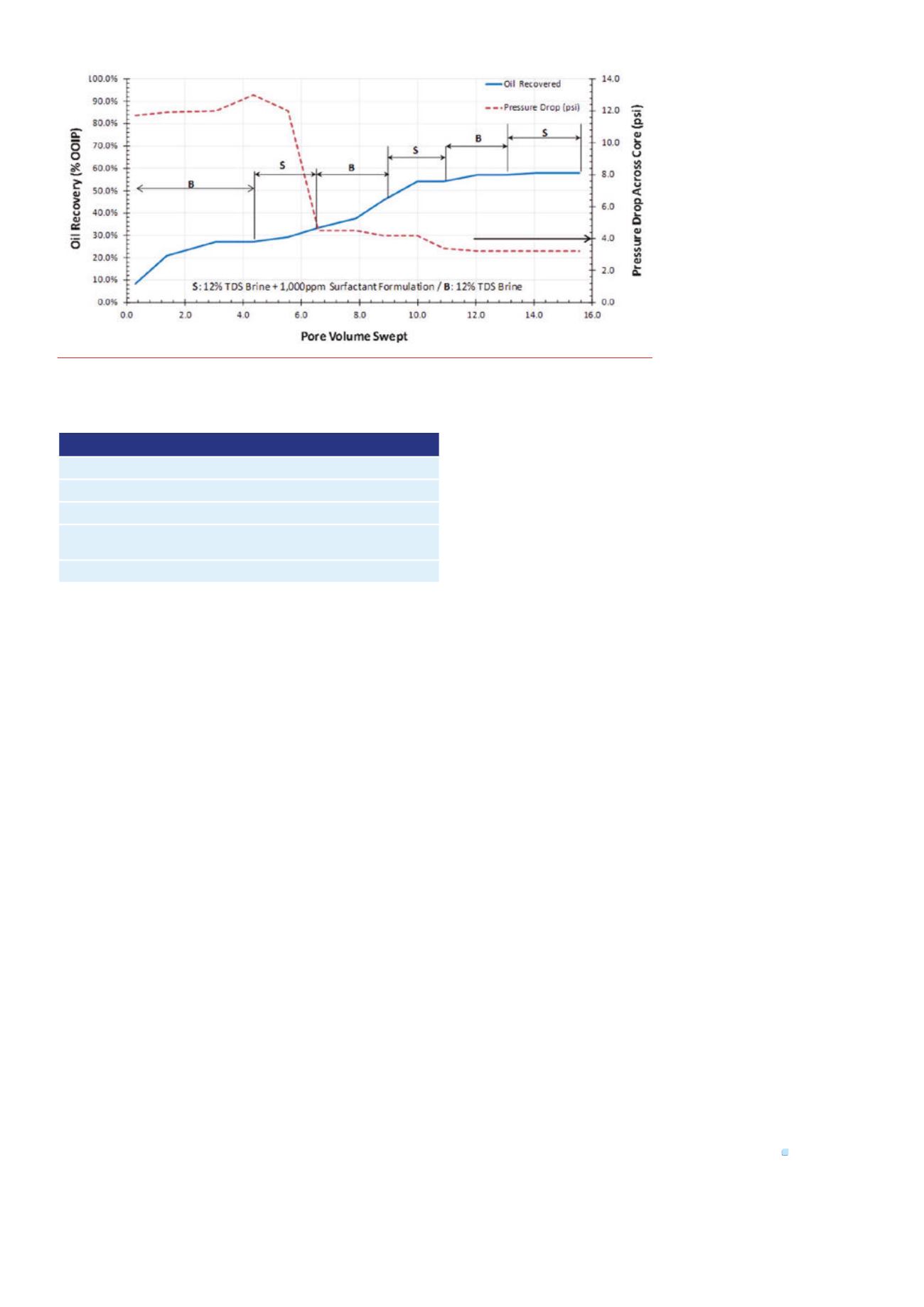
68 |
Oilfield Technology
June
2015
tailoring a carefully designed water composition appropriate to the
reservoir mineralogy. This involves changing the composition of
the injected water by removing certain salts and ions. Such water
treatment processes are very capital intensive. However, alteration of
wettability by using surfactant formulations in water flooding can be
relatively inexpensive to implement from a capital cost perspective
because the formulation can be stored and injected using mobile
skid units with simple injection equipment, which does not require
the high costs associated with facility development. Furthermore,
properly designed surfactant formulations have the ability to
function effectively in higher temperature and higher salt content
reservoirs. This is particularly relevant when discussing the use of
surfactant enhanced water flooding in the Middle East, where these
extreme reservoir profiles are common. A comprehensive portfolio
of surfactant formulations that are effective in favourably changing
the wettability of carbonate rocks at a wide range of temperature
and salinity conditions has been developed. Such formulations are
carefully evaluated in laboratory experiments, demonstrating their
potential use in improving water flooding performance in carbonate
reservoirs.
Labtestingandresults
One of the most important tests performed to characterise the
wetting behaviour of a surface is measuring the contact angle of
a water droplet on the surface. If the surface is oil‑wet, the water
droplet will not spread on the surface, and the contact angle (as
illustrated in Figure 2) will be greater than 90˚. On the other hand,
if the water spreads on to the surface, the measured contact angle
is less than 90˚; in this case, the surface is confirmed as water‑wet.
To test various surfactant formulations, an oil‑wet surface must
first be validated by placing a drop of brine (water with salt content
similar to formation water) on to a known hydrophobic surface. A
contact angle measurement of greater than 90˚ validates the surface
is oil‑wet. Then, a drop of the
surfactant formulation (solution
prepared in brine) is placed on the
same oil‑wet surface. An effective
wettability altering surfactant
should be able to enhance water
spreading on the surface, thus
leading to a contact angle lower
than 90˚. This phenomenon
is illustrated in Figure 2 for a
proprietary surfactant formulation
developed to effect wettability
alteration at a wide variety of
salinity conditions.
Additional tests are performed
by ageing calcite plates in crude
oil and exposing the oil‑wet cubes
to brine and a surfactant solution
in brine. While the plate exposed
to brine has significant amount of
oil sticking on to the surface, the one exposed to surfactant solution
looks drastically different (Figure 3). The surfactant effectively
spreads the brine over the oil‑wet surface, thereby changing the
initially oil‑wet plate to water‑wet, and effectively causing the oil to
bead up and release from the surface.
In order to validate the effectiveness of the surfactant
formulations to recover more oil from oil‑wet carbonate reservoirs
at representative reservoir conditions, core flooding studies are
performed simulating the oil recovery process from an oil bearing
carbonate formation. A sample result from one such experiment is
shown in Figure 4, where the oil recovered and the pressure drop
across a rock core during the flooding process are plotted compared
to the total rock pore volume swept by the flooding medium.
An outcrop Silurian dolomite core was used as representative
of a carbonate formation and Texas raw crude oil was chosen as
a representative crude oil from a carbonate formation. The rock
was first saturated with crude oil and then flooded with brine
until the oil cut in the produced fluid was less than 1%. This step
brings the oil saturation in the core down to residual saturation
to a water flood. Approximately 23% of the original oil in place
(OOIP) was recovered from water flooding. Alternate slugs of a
1000 parts per million (ppm) surfactant solution in brine followed
by chase brine were then flooded through the core. An additional
37% of the OOIP was recovered, leading to an overall oil recovery
factor of approximately 60% of the OOIP. The pressure drop across
the rock core also dropped significantly when the surfactant
formulation was introduced, indicating enhanced imbibition of
brine into the core.
Extensive lab testing has concluded that proprietary surfactant
formulations are compatible and can be optimised to meet a
wide range of carbonate reservoir conditions. Using specialised
formulations, tested and tuned according to reservoir conditions,
along with recommended reservoir injection strategies, the
performance of a water flooding process can be improved
significantly,
As the global population continues to grow, meeting new energy
challenges head on will remain a clear focus for operators. By
employing effective surfactant formulations, EOR processes can be
enhanced with minimal cost and increased simplicity.
Reference
1.
Schlumberger Oilfield Review, Summer 2007.
Figure 4.
Results fromsimulatingoil recoveryprocess inacore flood.Whileonly23%of theOOIPwas recoveredby
brine flooding (4 PV), introducing surfactant formulation in slugs resulted inanadditional recovery of 37%of the
OOIP. The pressure dropacross the core decreased significantlywhen the surfactant formulationwas introduced.
Properties of ideal surfactant formulations for wettability alteration
Effective wettablity altering agent at low dosages
Stability at challenging temperature and salinity conditions
Minimal water‑oil IFT reduction ‑ do not form viscous oil‑water emulsions
Minimal number of components with minimal chromatographic separation and
surfactant retention
No formation damage


